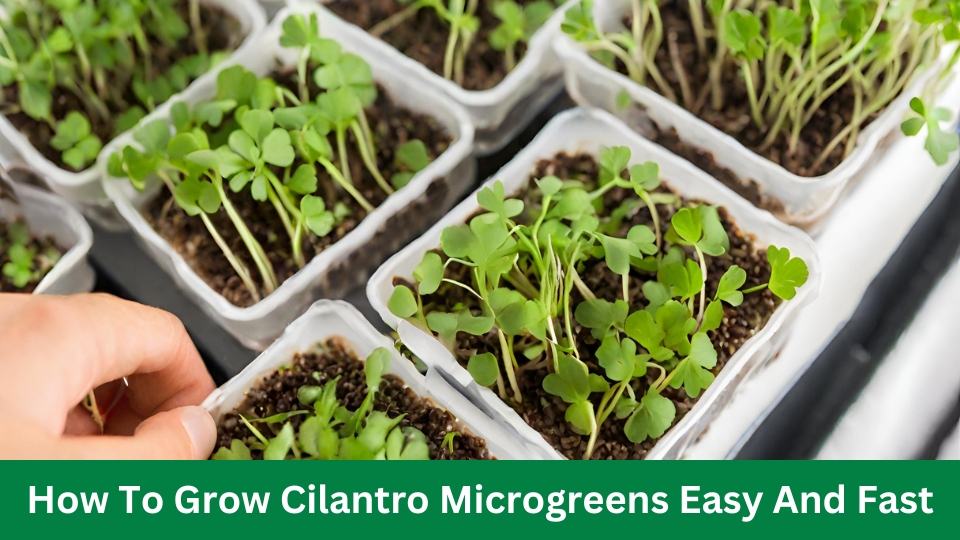Growing cilantro microgreens easily and quickly involves selecting high-quality seeds and providing them with adequate light, water, and airflow. Additionally, it is essential to maintain the correct temperature and humidity levels for optimal growth.
Here’s a concise guide to help you cultivate cilantro microgreens in no time. Cilantro microgreens are a versatile and nutritious addition to your meals, packed with flavor and health benefits. Growing cilantro microgreens can be simple and rewarding, whether you’re a seasoned gardener or a novice.
We will provide you with a step-by-step guide on how to grow cilantro microgreens easily and quickly.
Overview
This comprehensive guide teaches you how to grow cilantro microgreens easy and fast. Discover the step-by-step process and tips to ensure a successful harvest of these flavorful and nutritious greens in no time.
Brief Introduction To The Popularity And Benefits Of Cilantro Microgreens
Cilantro microgreens have recently gained immense popularity among gardening enthusiasts and health-conscious individuals. These tiny greens are flavorful and offer health benefits, making them a valuable addition to any culinary repertoire.
Microgreens, including cilantro microgreens, are the younger, more tender versions of fully-grown herbs and vegetables. They are harvested just a few weeks after germination, when they boast a higher nutrient concentration than their mature counterparts. Due to their compact size and fast growth, cilantro microgreens are ideal for urban gardeners or those with limited space.
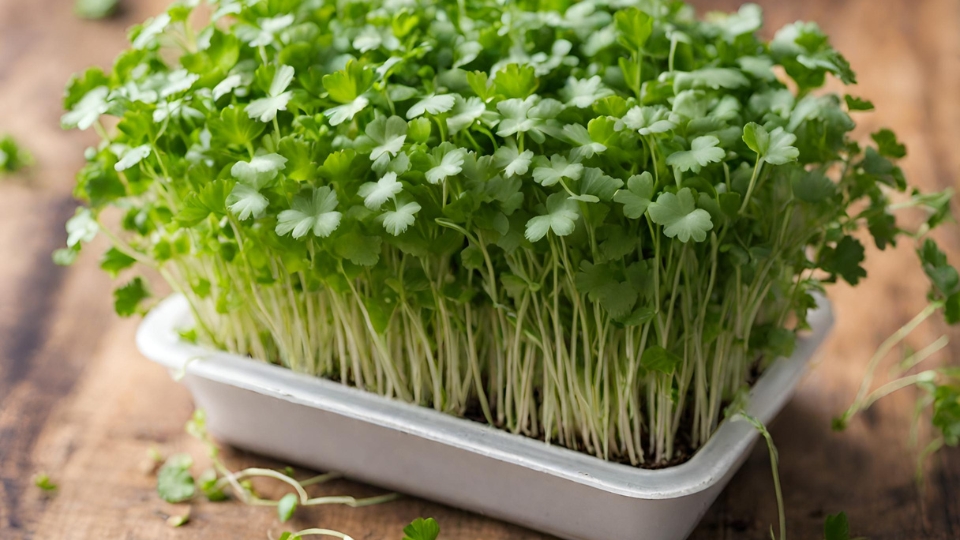
Benefits Of Growing Cilantro Microgreens
Growing cilantro microgreens at home yields numerous advantages for your taste buds and overall well-being. Let’s explore some of the benefits:
- Nutritional Powerhouse: Cilantro microgreens are known for their high nutritional content. They are an excellent source of vitamins A, C, and K and essential minerals like potassium and manganese. These micronutrients support a healthy immune system and promote optimal bodily functions.
- Intense Flavor: Cilantro microgreens pack a punch when it comes to flavor. Their delicate leaves boast a vibrant, citrusy, and herbaceous taste, adding a strong aromatic element to your culinary creations. These microgreens can turn a simple dish into a gourmet delight, whether used as a garnish, in salads or blended into sauces.
- Quick and Easy to Grow: One of the significant advantages of cultivating cilantro microgreens is how fast and hassle-free the process is. These little greens are among the easiest microgreens to grow, making them an excellent choice for beginners. Within a few weeks, you can enjoy a bountiful harvest that will keep your kitchen stocked with fresh, homegrown goodness.
- Year-Round Access: Another benefit of growing cilantro microgreens is that you can enjoy them year-round, regardless of the season. Whether winter or summer, you can always have fresh cilantro microgreens at your fingertips. These microgreens are ready to enhance your culinary endeavors. This convenience makes them a versatile and reliable ingredient for home cooks.
Now that we’ve explored the popularity and incredible benefits of cilantro microgreens, it’s time to explore the step-by-step process of growing them easily and quickly. Prepare to embark on a rewarding journey that will enhance your gardening skills and dinner table!
Health Benefits Of Cilantro Microgreens
Superfood cilantro microgreens are often overlooked. However, these tiny greens pack a powerful nutritional punch and offer health benefits. Whether you’re a fan of cilantro or not, incorporating cilantro microgreens into your diet can provide numerous advantages for your overall well-being.
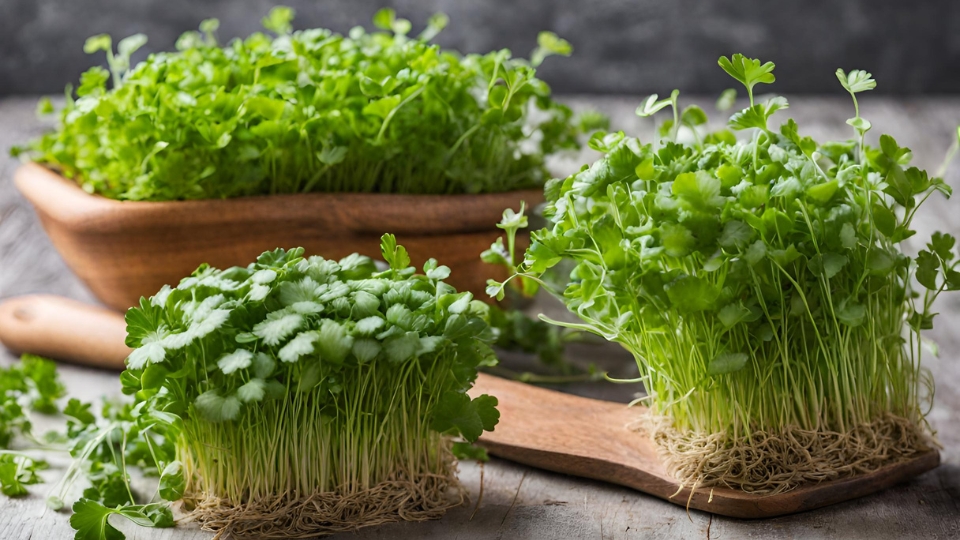
Nutritional Value Of Cilantro Microgreens
Cilantro microgreens are jam-packed with essential vitamins, minerals, and antioxidants. These fragile greens are high in vitamins A, C, and K. They contain small amounts of potassium, calcium, and iron. Moreover, cilantro microgreens are an excellent source of dietary fiber, providing a healthy boost to your digestive system.
Detoxification And Digestive Health
Besides adding flavor to your dishes, cilantro microgreens have detoxifying properties. Their high chlorophyll content aids in the elimination of heavy metals and toxins from the body. Regular consumption of cilantro microgreens supports liver function and enhances detoxification. Additionally, cilantro microgreens promote healthy digestion and help maintain a balanced gut microbiome.
Antioxidant And Anti-inflammatory Benefits
The antioxidants in cilantro microgreens help protect the body against harmful free radicals, thus reducing oxidative stress and inflammation. This contributes to a lower risk of chronic diseases such as heart disease and certain types of cancer. Including cilantro microgreens in your diet can provide a natural defense against cellular damage and support overall immune system health.
Heart Health And Blood Sugar Control
Cilantro microgreens contain compounds that may help regulate blood pressure and reduce cholesterol levels. Potassium in cilantro microgreens promotes healthy heart function and helps lower blood pressure. Moreover, fiber helps regulate blood sugar levels, making cilantro microgreens an excellent addition to a balanced diet for those with diabetes or at risk of developing the condition.
Easy And Fast To Grow
In addition to their health benefits, cilantro microgreens are remarkably easy and fast to grow. You can quickly grow cilantro microgreens in your home if you have limited space or lack a green thumb. You can enjoy a fresh and nutritious supply of cilantro microgreens year-round with just a few simple steps.
Choosing The Right Seeds And Soil
When growing cilantro microgreens, selecting the right seeds and soil is crucial for success. High-quality seeds and the ideal soil will lay the foundation for healthy and flavorful microgreens. This section will discuss some essential tips for choosing the best cilantro seeds and the optimal soil for growing microgreens.
Tips For Selecting High-quality Cilantro Seeds
When choosing cilantro seeds for your microgreens, it’s essential to consider their quality. Here are some tips to help you pick the perfect seeds:
- Look for certified organic seeds: Opting for certified organic seeds ensures you start with a healthy and chemical-free foundation.
- Check the expiration date: Always check the expiration date on the seed packet. Fresh seeds have a higher germination rate, which is essential for successful microgreen growth.
- Inspect the seed appearance: High-quality cilantro seeds are small, round, and have a uniform color. Avoid seeds that look discolored, damaged, or irregular in shape.
- Review and recommendations: Research reputable seed suppliers and customer reviews to ensure you get seeds with a proven track record of successful germination and growth.
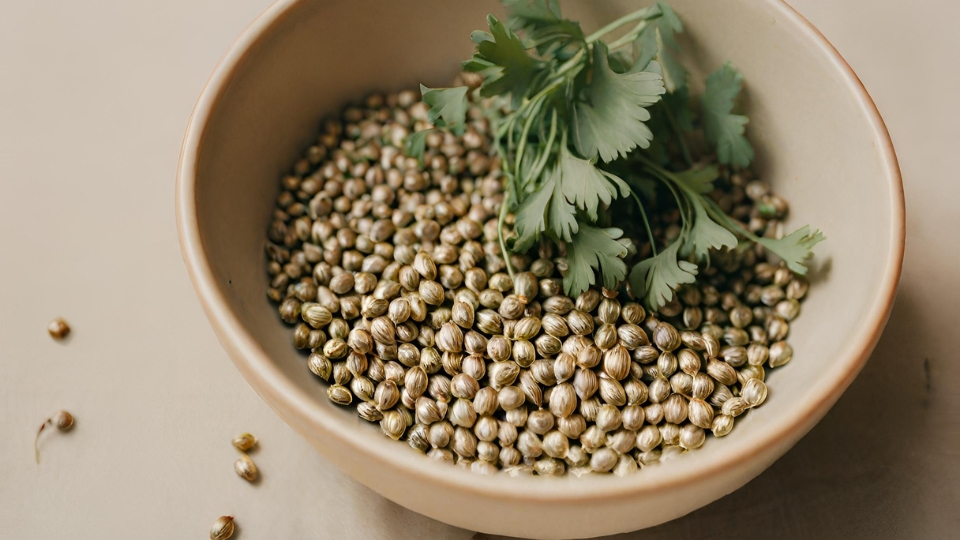
The Ideal Soil For Growing Microgreens
Choosing a suitable soil is crucial for providing nutrients and support to your cilantro microgreens. Here’s what you should consider:
- Seedling or microgreen-specific soil: Opt for a high-quality seedling or microgreen-specific soil mix specifically formulated to provide the optimal conditions for microgreen growth.
- Well-draining and sterilized soil: Ensure that the soil you choose is well-draining to prevent waterlogging, which can lead to root rot. Additionally, using sterilized soil helps prevent the growth of harmful pathogens.
- Organic matter and nutrients: Look for soil mixes that contain organic matter or compost, which provide essential nutrients to fuel the growth of your microgreens.
- pH levels: The ideal pH level for cilantro microgreens is slightly acidic, around 6.0 to 6.5. Therefore, consider using a soil pH tester to ensure optimal pH.
By following these tips for selecting high-quality seeds and choosing the ideal soil, you are setting yourself up for success in growing cilantro microgreens. The right seeds and soil will give your microgreens the best start, enabling them to flourish and provide a nutritious and flavorful addition to your meals.
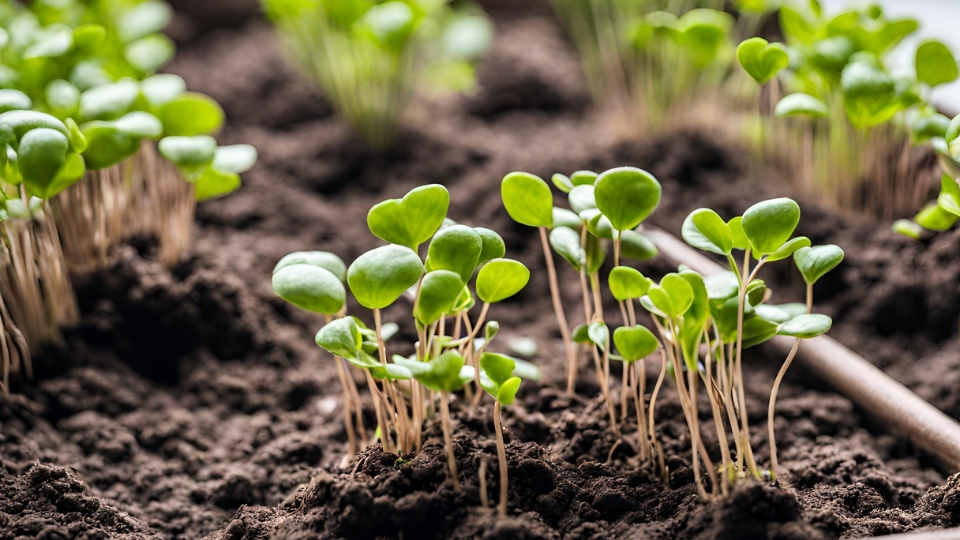
Step-by-step Guide To Growing Cilantro Microgreens
Growing cilantro microgreens at home is a simple and rewarding process. With their vibrant green color and distinctive flavor, cilantro microgreens are popular among many home gardeners. This step-by-step guide will walk you through growing cilantro microgreens, from preparation to harvesting.
Preparation: Soaking And Rinsing The Seeds
Before planting cilantro microgreens, it is essential to prepare the seeds properly. Start by soaking the seeds in water for about 8-12 hours. This helps to soften the seed coat and improve germination.
After soaking, rinse the seeds thoroughly to remove any dirt or debris. This can be done by placing the seeds in a fine-mesh strainer and running water over them while gently stirring. Once clean, let the seeds drain for a few minutes.
Planting: Spreading The Seeds Evenly On The Soil
Now that the seeds are clean and ready, it’s time to plant them. Fill a shallow tray with a well-draining potting mix, leaving about half an inch of space at the top. Spread the cilantro seeds evenly over the soil surface, ensuring they are not too crowded.
You can use a small spray bottle to mist the seeds with water to ensure even distribution. This helps the seeds stick to the soil and prevents them from rolling around during watering.
Caring: Watering, Providing Proper Light And Ventilation
Proper care is crucial for the successful growth of cilantro microgreens. Water the seeds gently, using a misting sprayer or a watering can with a fine spout. Avoid overwatering, as it can lead to mold or fungal growth.
Place the tray in a warm spot with ample sunlight or under grow lights to provide adequate light for germination. Cilantro microgreens prefer bright but indirect light. If using grow lights, position them about 6 inches above the tray and keep them on for 12-16 hours daily.
Ensure good ventilation by propping the tray at a slight angle, allowing air to circulate the plants. This helps prevent dampness and encourages healthy growth.
Harvesting: Timing And Techniques For Harvesting Cilantro Microgreens
Timing is crucial when harvesting cilantro microgreens. The ideal time to harvest is when the gardens have developed their first set of true leaves. This usually takes 2–3 weeks after planting.
To harvest, gently cut the microgreens just above soil level using clean scissors. Avoid pulling or uprooting the plants, which can damage the delicate roots. Rinse harvested microgreens in cool water to remove debris before consumption.
With this step-by-step guide, growing cilantro microgreens at home has never been easier. Enjoy these nutritious greens’ fresh and vibrant flavors in your favorite dishes!
Common Issues And Troubleshooting
Learn how to grow cilantro microgreens easily and quickly with our troubleshooting guide. Discover common issues and expert tips to ensure successful cultivation.
Identifying And Resolving Common Problems Such As Mold, Pests, Or Slow Growth
Cilantro microgreens are a delightful addition to any dish, adding a fresh and vibrant flavor. However, like other plants, they can sometimes encounter issues hindering their growth. This section will discuss some common problems you may face when growing cilantro microgreens and provide troubleshooting tips to overcome them.
1. Mold
Mold can be a common issue when growing cilantro microgreens, especially if the growing conditions are too damp. If you notice mold growth, it is essential to take immediate action to save your crop. Here are some steps you can take to address this problem:
- Remove any affected microgreens immediately to prevent the spread of mold.
- Ensure proper air circulation by using a fan or opening windows to prevent moisture buildup.
- Adjust the watering schedule by allowing the soil to dry out before watering again. Consider using a natural mold inhibitor, such as a diluted mixture of hydrogen peroxide and water, to prevent mold growth.
- Starting afresh with new seeds and a clean growing medium might be beneficial if the mold persists.
2. Pests
Pests can be a nuisance when growing cilantro microgreens, but you can keep them at bay with proper precautions. Here are some tips to identify and deal with common pests:
- Monitor your microgreens regularly for signs of pests, such as tiny insects or leaf holes.
- If you detect pests, try using natural pest controls like neem oil or insecticidal soap to deter them.
- Use sticky traps or barriers, like diatomaceous earth, to prevent crawling insects from reaching your microgreens.
- Regularly clean your growing trays and equipment to minimize the chances of pest infestation.
3. Slow Growth
If your cilantro microgreens are experiencing slow growth, there may be a few factors that could be contributing to this issue. Here are some troubleshooting tips to enhance their growth rate:
- Ensure the growing medium is well-draining and provides adequate moisture retention.
- Provide sufficient light by placing the microgreens in a bright area or using artificial grow lights.
- Verify that the temperature is within the optimal range for cilantro microgreens, usually around 60-70°F (15-21°C). –
- Check the seed quality to ensure viability. Replacing old or expired seeds can significantly improve germination rates.
- Avoid overcrowding the growing tray, as this can limit airflow and lead to slower growth. You can promptly identify and address these common issues to ensure your cilantro microgreens thrive and flourish.
Monitor your microgreens regularly and adjust as needed to promote healthy growth.
Using Cilantro Microgreens In The Kitchen
Elevating culinary creations and incorporating fresh herbs is key. Cilantro microgreens, with their vibrant flavor and delicate texture, offer an exciting twist to any dish. Bursting with essential nutrients and boasting an intense aroma, these tiny greens pack a punch for your taste buds.
This section will explore creative ways to incorporate cilantro microgreens into various dishes. We will provide recipe ideas and serving suggestions that will reap the benefits of these flavorful microgreens. Let’s dive in!
Creative Ways To Incorporate Cilantro Microgreens Into Various Dishes
- Create a colorful and nutritious salad: Toss cilantro microgreens with fresh vegetables, such as cherry tomatoes, cucumbers, and bell peppers. Add a squeeze of lime juice and a drizzle of extra-virgin olive oil for a refreshing and vibrant salad.
- Add a flavor boost to your sandwiches and wraps: Sprinkle a handful of cilantro microgreens onto your favorite sandwich or wrap for an extra burst of freshness. Pair it with sliced avocado, grilled chicken, and a tangy dressing for a mouthwatering combination.
- Upgrade your soups and stews: Add cilantro microgreens as a garnish to your favorite soups or stews to enhance the overall flavor profile. The bright green leaves will add visual appeal and a subtle hint of cilantro.
- Create a zesty salsa: Combine diced tomatoes, onions, fresh cilantro microgreens, jalapenos, and a squeeze of lime juice for a vibrant and flavorful salsa. Serve it with tortilla chips or a topping for grilled meats or fish.
Recipe Ideas And Serving Suggestions
If you’re looking for specific recipes to incorporate cilantro microgreens into your meals, here are a few ideas:
- Cilantro Microgreens Pesto Pasta: Combine a handful of cilantro microgreens, garlic cloves, pine nuts, Parmesan cheese, lemon juice, and olive oil until smooth. Toss the pesto sauce with your favorite pasta, and garnish with additional cilantro microgreens for freshness.
- Mango Cilantro Microgreens Smoothie: In a blender, combine ripe mango chunks, a handful of cilantro microgreens, Greek yogurt, a squeeze of lime juice, and a drizzle of honey. Blend until smooth, and enjoy a tropical and nutritious smoothie.
- Crispy Cilantro Microgreens Tacos: Fill warm tortillas with your choice of protein, such as grilled chicken or sautéed shrimp. Top with cilantro microgreens, diced tomatoes, sliced avocado, and a dollop of sour cream for a flavorful and satisfying taco experience.
Experiment with these recipe ideas and adapt them to suit your taste preferences. Remember, cilantro microgreens are incredibly versatile and can be used in many dishes to add freshness and flavor.
FAQ For How To Grow Cilantro Microgreens Easy And Fast
How Long Does It Take to Grow Cilantro Microgreens?
Cilantro microgreens usually take 10 to 14 days to grow from seed to harvest.
How Do You Grow Cilantro Fast?
To grow cilantro fast, follow these tips: Plant the seeds in well-draining soil in a sunny location. Keep the soil consistently moist but not soggy. Provide an adequate amount of organic fertilizer. Harvest the outer leaves regularly to encourage new growth.
Control pests and diseases as necessary.
What Microgreens Grow In 10 Days?
Broccoli, radish, and kale microgreens are some of the varieties that can be grown in just ten days. These fast-growing greens are packed with nutrients and flavors, making them perfect for adding to salads, sandwiches, and smoothies. Enjoy fresh, homegrown microgreens in no time!
How Do I Grow Cilantro Microgreens At Home?
Growing cilantro microgreens at home is simple. Start by soaking the seeds in water for a few hours, then spread them evenly on a tray filled with potting soil. Cover the tray with a plastic dome to create a mini greenhouse effect, and mist it with water daily.
In about two weeks, your cilantro microgreens will be ready to harvest.
Conclusion
To sum up, growing cilantro microgreens can be a simple and speedy process. Following the proper steps, you can enjoy a fresh and flavorful addition to your meals in no time. Ensure adequate warmth, moisture, and light to ensure optimal growth.
With patience and care, you’ll soon harvest your cilantro microgreens effortlessly. Happy gardening!
Video Source https://www.youtube.com/watch?v=r7nyPY3Saak

